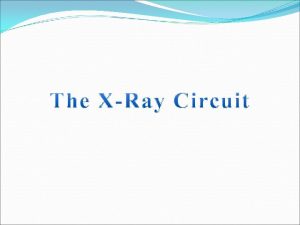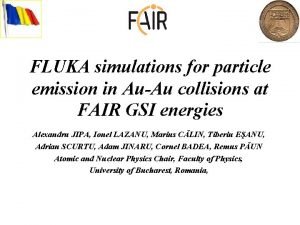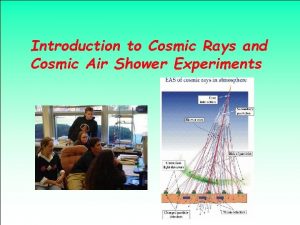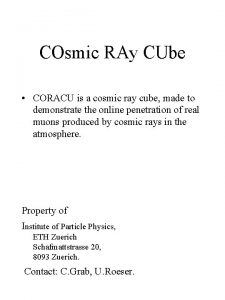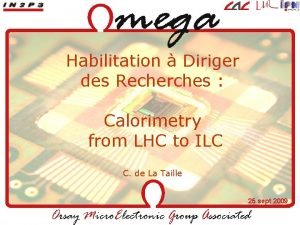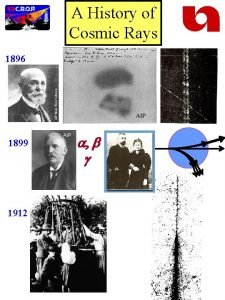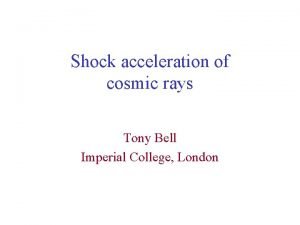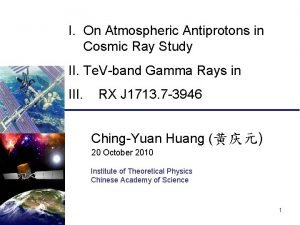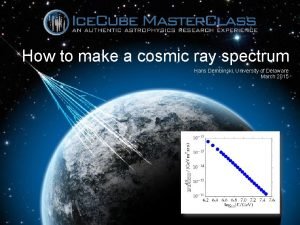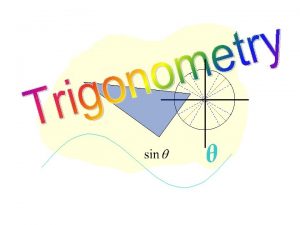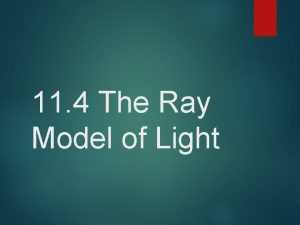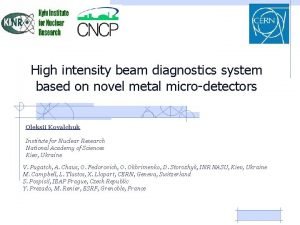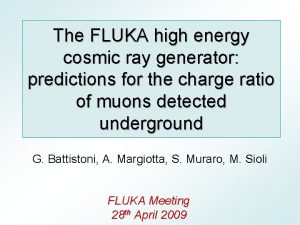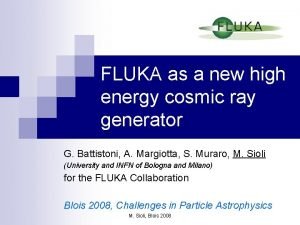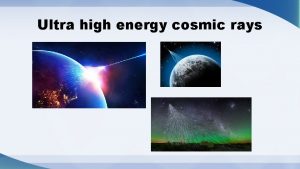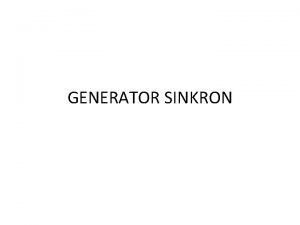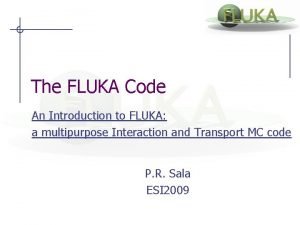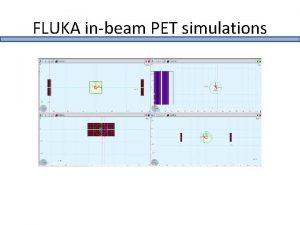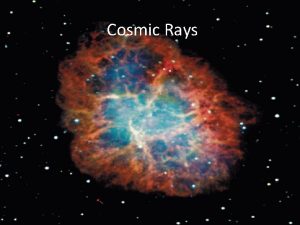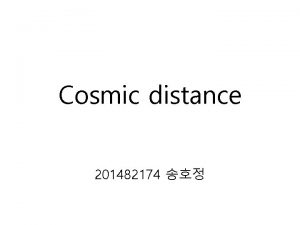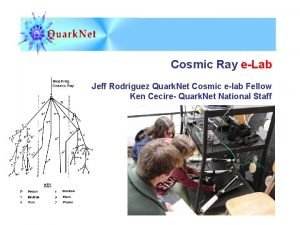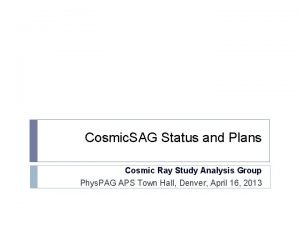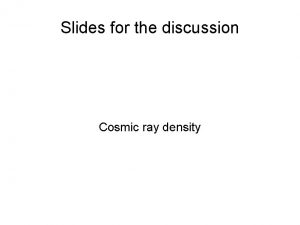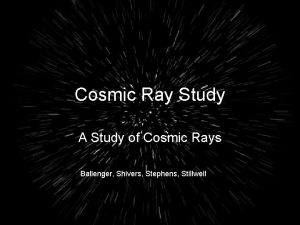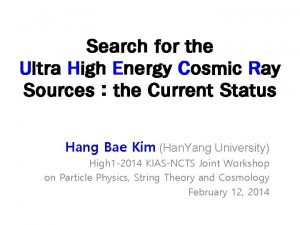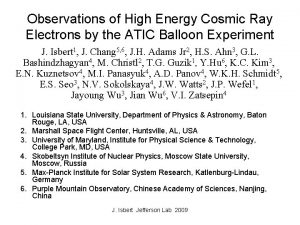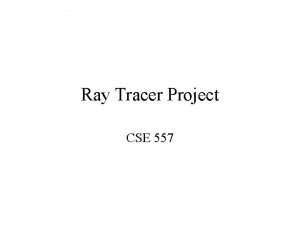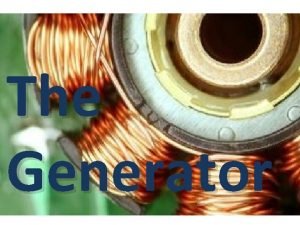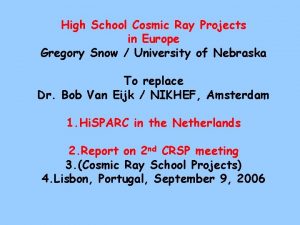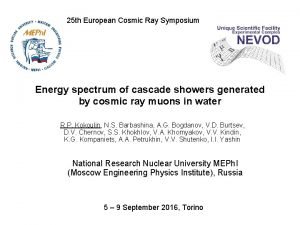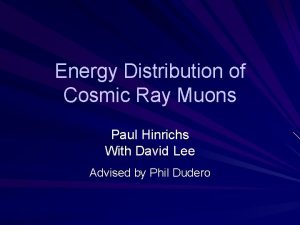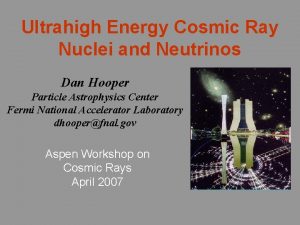The FLUKA high energy cosmic ray generator predictions
























- Slides: 24

The FLUKA high energy cosmic ray generator: predictions for the charge ratio of muons detected underground G. Battistoni, A. Margiotta, S. Muraro, M. Sioli (University and INFN of Bologna and Milano) for the FLUKA collaboration 44 th Rencontres de Moriond Very High Energy Phenomena in the Universe

In the environment of the FLUKA Monte Carlo code application to cosmic rays physics, a new generator for high energy cosmic rays is under development, with the aim of extend the existing FLUKA cosmic rays library to include the Te. V region. The application of FLUKA in cosmic ray physics arises from the interest in applied physics topics (radioprotection in space or in atmosphere) and in basic research (calculation of atmospheric neutrino fluxes). Generator dedicated to: • physics of high energy underground muons • exploiting the full integration in the calculation of both air shower development and muons transport in the rock. Aim: predict multiple muon rates for different primary masses 2 and energy within the framework of a unique simulation model.

Work under way within the ICARUS and OPERA collaborations at Gran Sasso. First application: Analyze the predictions for the charge ratio of underground muons. Compare preliminary results with data from an ongoing experiment (MINOS). 3

FLUKA http: //www. fluka. org Authors: A. Fasso`1, A. Ferrari 2, J. Ranft 3, P. R. Sala 4 1 SLAC Stanford, 2 CERN, 3 Siegen University, 4 INFN Milan Interaction and Transport Monte Carlo code • FLUKA is a general purpose tool for calculations of particle transport and interactions with matter, covering an extended range of applications (Shielding, Radiobiology, High energy physics, Cosmic Ray physics, Nuclear and reactor physics). • Built and maintained with the aim of including the best possible physical models in terms of completeness and precision. • Continuously benchmarked with a wide set of experimental data from well controlled accelerator experiments. Hadronic interaction models: based on a theoretical microscopic approach (no parametrizations). Free parameters are set (thin target experiments at accelerators) and kept fixed for all projectile-target combinations and energies. => High predictivity also in regions where experimental data are 4 not available.

The FLUKA hadronic Models for a detailed study of the validity for CR studies see hep-ph/0612075 and 0711. 2044 Hadron-Hadron Elastic, exchange Phase shifts data, eikonal P<3 -5 Ge. V/c Resonance prod and decay Hadron-Nucleus E < 5 Ge. V High Energy PEANUT Glauber-Gribov Sophisticated multiple interaction GINC s Preequilibrium Coarser GINC Coalescence > 5 Ge. V Elab low E π, K Special High Energy DPM hadronization Nucleus-Nucleus E< 0. 1 Ge. V/u BME Complete fusion+ peripheral 0. 1< E< 5 Ge. V/u r. QMD-2. 4 modified new QMD E> 5 Ge. V/u DPMJET DPM+ Glauber+ GINC Evaporation/Fission/Fermi break-up Relevant for HE C. R. physics deexcitation DPM: soft physics based on (multi)Pomeron exchange 5 DPMJET: soft physics of DPM plus 2+2 processes from p. QCD

The underground muons generator: main features Geometry setup Earth: sphere of radius R = 6378. 14 km Atmospheric geometry & profile: 100 concentric spherical shells whose density and composition is varied according to the U. S. Standard Atmospheric Model. Gran Sasso mountain: spherical body whose radius is dynamically changed, according to the primary direction and to the Gran Sasso mountain map. LNGS laboratory: • experimental underground halls • ICARUS and OPERA detectors volumes • rock box where muon–induced secondary are activated (e. m. & hadronic showers from photo-nuclear interaction). 6

Primary spectrum Sampled from a primary mass composition model (a description of the relative abundances of cosmic rays and their energy spectra), at present, derived from the analysis of the MACRO experiment at Gran Sasso. For each primary nucleus and for each amount of rock to be crossed, we compute the minimum energy required to produce at least one muon underground (probability < 10 -5 to survive). Hadronic interaction model High energy cosmic ray interactions relevant for this work are treated in FLUKA by means of the interface to DPMJET. II. 5. (hadron-hadron, hadron-nucleus and also nucleus-nucleus collision by means of the Glauber-Gribov mechanism) 7

Muon bundle from primary iron nuclei (E ≈ 105 Te. V) in the ICARUS T 600 detector 8

First application: prediction for the charge ratio of underground muons Muons that reach the Earth come from mesons with enough energy: to reflect the forward fragmentation region of the primary initiated interaction and to “remember” the nature of the projectile (there are more protons than neutrons in the primary spectrum) Þ The muon charge ratio reflects the excess of π+ over π- and K+ over K−. NOTE: π and K hadronic production are affected by uncertainties up to 20% 9

Validation of the DPMJET-III hadronic models: Comparison with the NA 49 experiment Data from the NA 49 experiment at CERN SPS particle production by p beams on p, C targets: 158 Ge. V/c beam momentum First published results: Eur. Phys. J. 45 (2006), 343 hep-ex/0606028 hep-ex/0606029 + , - production p + p p + C + , - production as a function of Feynman-x 10

SPY experiment (CERN North Area) p + Be => π+ + X Nucl. Instr. Meth. A 449, 609 (2000) Ecm = 450 Ge. V p + Be => π- + X 11

Benchmark for the CNGS beam construction. Limited phase space for cosmic rays physics. Nucl. Instr. Meth. A 449, 609 (2000) p + Be => K+ + X Ecm = 450 Ge. V p + Be => K- + X 12

FLUKA for Cosmic Rays validation at low energy (Eμ< 100 Ge. V) FLUKA simulations comparison with the experimental data of atmospheric muons taken at the top of Mt. Norikura, Japan, with the BESS detector. (Phys. Lett. B 564 (2003), 8 – 20) • 2770 m above sea level • Geomagnetic Cut-off: 11. 2 GV • cone of ~11 o The energy range for muons extends up to 100 Ge. V. Results within 20%. S. Muraro Ph. D Thesis Black points: exp. Data Open symb: FLUKA Simulation m- + m 13

The muons result from pions and kaons that decay before they interact in the atmosphere. Instead of π production, because of the strangeness of K, inclusive cross section for K+ production is bigger then inclusive cross section for K- → the K+/K− ratio is larger than the π+/π− ratio. As energy increases, the fraction of muons from kaon decays also increases: the longer-lived pions (π± : cτ0 = 780 cm, ε = 115 Ge. V) start to interact more before decaying than the shorter-lived kaons (K± : cτ0 = 371 cm, ε = 850 Ge. V). critical energy ε: beyond this energy interaction process dominates on decay. 14

FLUKA in the Te. V region: μ/All from π and K μ (from π) / All μ (from K) / All 15

As energy increases, kaon decays became a more important contribution to the muon charge ratio. Since Nμ+ Nμ- Nμ+ Nμ− (from K) > (from π) the total muons charge ratio is expected to increase with energy 16

FLUKA for Cosmic Rays validation (Eμ < 1 Te. V) FLUKA simulations comparison with the experimental data of atmospheric muons charge ratio from L 3 + COSMIC experiment (hep-ex/0408114). Vertical 0. 975 < cosθ < 1. RFLUKA = 1. 295 0. 0482 Rexp = 1. 285 0. 484 Black points: exp. Data Open symb: FLUKA At large angle 0. 525 < cosθ < 0. 6 (S. Muraro Ph. D Thesis) 17

FLUKA in the Te. V region: muon charge ratio from K π μ+ / μ- FLUKA PREL IMIN 1. 312 0. 0155 ARY μ+ / μ- FLUKA from π 1. 22017 0. 0163948 μ+ / μ- FLUKA from K 18 1. 78605 0. 0458639

MINOS hep-ex 0705. 3815 Charge Ratio at the Surface = 1. 371± 0. 003 RFLUKA = 1. 295 0. 0482 RFLUKA = 1. 312 0. 0155 FLUKA prediction ~5% lower then MINOS exp. data => Possible lack of K production in FLUKA 19

Conclusions FLUKA models have been benchmarked with experimental data from accelerator experiments and from atmospheric muons experiments (BESS: Eμ < 100 Ge. V; L 3+C: Eμ < 1 Te. V) The FLUKA charge ratio prediction in the Te. V region is ~5% lower then MINOS experimental results Uncertenties on π and K production in hadronic models can reach 20% because of lack of data from K production experiments at high energy => Possible lack of K production in FLUKA We are waiting for OPERA data 20

Thank you 21

Muon charge ratio VS muon bundle multiplicity In the primary heavy elements the ratio of primary protons to neutrons decreases with respect to primary protons → the muon charge ratio is expected to decrease. Muon bundle high multiplicity ↕ High primary energy and High primary mass number Muon charge ratio is expected decreases with growing multiplicity 22

xlab = Ej/Ei ratio of the total energies of the secondary particle j over the primary particle i d. Nij/dxlab differential multiplicity distributions of secondary j as produced by primary i in collisions with air nuclei as a function of xlab ”spectrum weighted moments” Zij : the multiplicity of secondary particles j as produced by primary particles i in interaction, weighted for the primary spectrum. Strictly bound to inclusive cross sections. γ = 2. 7 approximate spectral index of the differential cosmic ray spectrum. 23

For isospin symmetry: On the other hand: where N is a nucleon. K+ and 0 (S = +1), can be produced in association with a leading Λ or Σ barion, whereas production of K requires production of a strange-antistrange pair from the sea in addition to the leading nucleon So the K+/K− ratio is larger than the π+/π− ratio. Spectrum weighted moments (γ = 2. 7) for secondary particles produced in p-air collisions as a function of the projectile kinetic energy in the 24 FLUKA code.
 X ray circuit diagram
X ray circuit diagram Fluka course
Fluka course Remnant weisskopf code
Remnant weisskopf code Fluka simulation
Fluka simulation Cosmic air flights
Cosmic air flights Cosmic ray elab
Cosmic ray elab Coracu
Coracu Bit flip cosmic ray
Bit flip cosmic ray Cosmic ray
Cosmic ray Cosmic ray spectrum
Cosmic ray spectrum Cosmic waves
Cosmic waves Cosmic ray
Cosmic ray Tan 30 unit circle
Tan 30 unit circle Ray ray model
Ray ray model Ray casting vs ray tracing
Ray casting vs ray tracing Human design population
Human design population Energy energy transfer and general energy analysis
Energy energy transfer and general energy analysis Energy energy transfer and general energy analysis
Energy energy transfer and general energy analysis High intensity x-ray beam machine
High intensity x-ray beam machine Will may and might for predictions
Will may and might for predictions Names like romeo and juliet
Names like romeo and juliet Prediction vs inference venn diagram
Prediction vs inference venn diagram Good readers make prediction by
Good readers make prediction by Making predictions ppt
Making predictions ppt Make a prediction
Make a prediction
